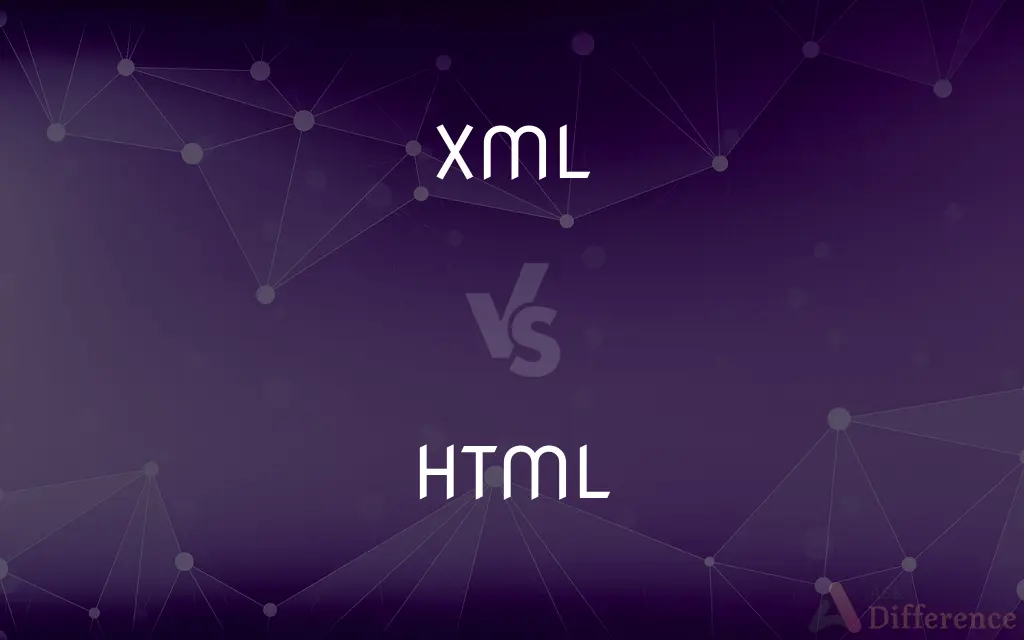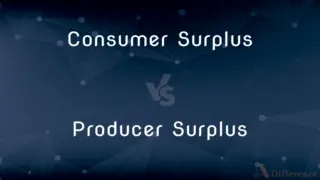XML vs. HTML — What's the Difference?
By Tayyaba Rehman — Published on January 12, 2024
XML defines data and its structure; HTML displays and formats data for webpages.

Difference Between XML and HTML
Table of Contents
ADVERTISEMENT
Key Differences
XML, or Extensible Markup Language, is designed to store and transport data, providing a structure for information with user-defined tags. HTML, HyperText Markup Language, is primarily focused on presenting data on web browsers, utilizing predefined tags to create the structure and layout of a web page.
While XML allows the creation of custom tags, providing a flexible way to organize and share structured data, HTML uses a fixed set of tags to display content and handle multimedia. XML's tags are not predefined, unlike HTML, which has a standard set of tags recognized by web browsers.
XML serves as a tool for data interchange and is often used for its self-descriptive nature in web services, configuration files, and more. HTML, conversely, is the backbone of web content, providing the framework for web page design and interaction with users.
Both XML and HTML are textual data formats, but XML is used for the transport and storage of data, with a focus on the data's meaning. HTML, in contrast, ensures that the data is displayed in a user-friendly manner on the web, focusing more on how the data looks.
XML is strict about document structure, requiring all elements to be properly nested and closed. HTML, on the other hand, is often more forgiving of errors, and modern web browsers can render HTML pages even if the markup contains minor mistakes.
ADVERTISEMENT
Comparison Chart
Purpose
Data storage and transport
Web page structure and presentation
Tag Types
Custom tags defined by the user
Predefined tag set
Structure
Strictly hierarchical and well-formed
Loosely hierarchical, more tolerant of errors
Data Type
Designed to carry data with no presentation
Designed to display data with formatting
Extensibility
Highly extensible and allows namespaces
Not extensible, fixed markup language
Compare with Definitions
XML
XML is a flexible text format derived from SGML, often used to represent complex data structures.
Our configuration settings are saved in an XML file.
HTML
HTML is the backbone of web page design, allowing multimedia integrations and links.
We embedded a video into the webpage using HTML.
XML
XML is a markup language for document encoding that is both human- and machine-readable.
The company shares its data between departments using XML.
HTML
HTML uses tags to structure web content.
HTML tags like
and
organize text into paragraphs and headings.
XML
XML focuses on transporting and storing data without presentation.
The data feed was received in an XML format.
HTML
HTML is a core technology of the Internet used to build and render web pages.
Every webpage you visit is structured with HTML.
XML
XML is platform-independent, making it ideal for data interchange.
We use XML to ensure our data can be read by different software.
HTML
HTML is the standard markup language for creating web pages and web applications.
The new website's layout is coded in HTML.
XML
XML allows users to define their own tags.
For the project, we created custom XML tags to represent each element.
HTML
HTML documents are rendered by web browsers as web pages.
My browser interprets HTML code to display the page.
XML
An international standard metalanguage for creating markup languages that structure digital information in a way that allows for the exchange, display, and storage of data independent of proprietary operating systems and hardware devices.
HTML
A markup language used to structure text and multimedia documents and to set up hypertext links between documents, used extensively on the World Wide Web.
HTML
A set of tags and rules (conforming to SGML) for using them in developing hypertext documents
Common Curiosities
Can HTML be used for data storage?
No, HTML is meant for displaying data on web pages, not for data storage.
Is HTML case-sensitive?
No, HTML is not case-sensitive, but XML is.
Can I use XML to format web pages?
XML is not designed for formatting; it is for structuring data. You would use CSS or XSLT with XML for formatting.
What is XML primarily used for?
XML is primarily used for storing and transporting data with a focus on what data is.
Is HTML extensible like XML?
No, HTML is not as extensible; it has a set number of tags.
Is it possible to validate both XML and HTML documents?
Yes, XML documents can be validated using DTDs and Schemas, while HTML documents can be checked against W3C standards.
Can XML handle multimedia content like HTML?
No, XML itself does not handle multimedia; it would need to be combined with other technologies like XHTML.
Do XML documents need a specific structure?
Yes, XML documents must be well-formed and follow a specific structure.
Are XML tags the same as HTML tags?
No, XML tags are user-defined and can be created to suit the data, whereas HTML tags are predefined.
Do XML and HTML serve the same purpose?
No, XML is for data carriage, while HTML is for data presentation on the web.
Can XML and HTML be used together?
Yes, XML can be used to store data, and HTML to display that data on web pages.
Is it necessary to learn XML for web development?
It's not necessary, but knowing XML is beneficial for handling web services and data interchange.
How do browsers handle XML and HTML?
Browsers render HTML directly to display web pages, while XML needs to be styled with CSS or XSLT for display.
Does HTML require a closing tag for every element?
While most HTML elements require closing tags, some, like ![]() and
and
, are self-closing.
, are self-closing.
Are comments in XML and HTML similar?
Yes, both XML and HTML use syntax for comments.
Share Your Discovery

Previous Comparison
Consumer Surplus vs. Producer Surplus
Next Comparison
Relational Algebra vs. Relational CalculusAuthor Spotlight
Written by
Tayyaba RehmanTayyaba Rehman is a distinguished writer, currently serving as a primary contributor to askdifference.com. As a researcher in semantics and etymology, Tayyaba's passion for the complexity of languages and their distinctions has found a perfect home on the platform. Tayyaba delves into the intricacies of language, distinguishing between commonly confused words and phrases, thereby providing clarity for readers worldwide.













































